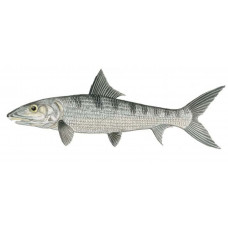Latin name
Albula vulpes
Other names
Banana fish, phantom, silver ghost, ladyfish, grubber, silver streak, tenny; French: banane de mer, sorte de mulet; Hawaiian: o’io; Japanese: soto-iwashi; Portuguese: juruma; Spanish: macabí, zorro.
Identification
The body, except for the head, is covered with rather fine scales. The back is dark greenish, the sides and belly are silvery-white, with longitudinal dark stripes. The head is small. The eyes are medium-sized. The upper jaw does not reach the vertical of the front edge of the eye. The dorsal fin is located in the middle of the back, its base lies in front of the pelvic fins, the last ray is not elongated. Behind the posterior half of the dorsal fin are the pelvic fins. The bases of the pectoral and pelvic fins have axillary scales. The lateral line is straight. Dorsal fin has 15-19 rays; anal 8-9; pectoral 15-17; pelvic 9-10; gill stamens on 1st arch (7-10) + (8-12); scales in lateral line 62-84; vertebrae 68-80; pyloric appendages 13.
Distribution
Bonefish are found all over the world in tropical and subtropical waters. Around North America, they are most abundant in the Florida Keys, the Bahamas, and the Caribbean, more in winter than summer; they are also somewhat abundant in Belize, Panama, and other Central American countries.
Habitat
It lives in warm coastal areas, in shallow intertidal waters, including around muddy and sandy shoals, and in mangrove lagoons. They also are found in waters up to 30 feet deep and can live in oxygen-poor water.
Size
Although the average Bonefish weighs 2 to 5 pounds, bonefish weighing up to 10 pounds are not uncommon. They can grow up to 41 inches in length, averaging 1 to 21⁄2 feet. The world record catch on all tackle is a 19-pound fish.
Life history and Behavior
Bonefish are thought to spawn from late winter to late spring, depending on the area. A young Bonefish fish looks like an eel until it passes the larval stage of leptocephalus. During this period, it grows to 21⁄2 inches in length. During this period, then metamorphosis occurs, resulting in the young bonefish being halved in size. The fins begin to appear during shrinkage, and after 10-12 days it reaches the body shape of an adult fish, only in miniature size. The young migrate to the open sea. In general, the Bonefish is a gregarious fish.
Food and feeding habits
Bonefish feed on crabs, shrimp, clams, crustaceans, sea worms, sea urchins, and small fish. They prefer to feed at high tide, often doing so near mangroves. They dig into the sand with their snouts in finding of food, and are sometimes spotted with their heads down and their tails up. Such fish are called bonyfish. Fish eating leads to silting.
Reproduction
First mature at the age of two years with a body length of 25 cm. Keeps in flocks. Probably spawning occurs in the tropics and subtropics year-round in the deep shelf areas, the larvae of this species are caught in different months of the year. The Bonefish leptocephala is similar in shape to a willow leaf. The smallest size (57 mm, SL 51 mm) had leptocephales caught off the coast of Florida. After reaching a length of 8-9 cm (with a well-defined forked tail fin), leptocephali begin to shrink, their body shortens and thickens, at a length of about 3 cm their body becomes similar in shape to adult fish. Bonefish feed on worms, mollusks, shrimps, crabs and small fish.
| Classification | |
| Phylum | Chordata |
| Class | Actinopterygii |
| Squad | Scorpaeniformes |
| Family | Scorpaenidae |
| Genus | Albula |
| Species | A. vulpes |
| Features | |
| Conservation status | Near Threatened |
| Habitat | Littoral |
| Life span, years | no information |
| Maximum body weight, kg | 10 |
| Maximum length, cm | 104 |
| Sailing speed, m/s | 16.7 |
| Threat to people | Edible |
| Way of eating | predator |
Bonefish
Tags: Bonefish



